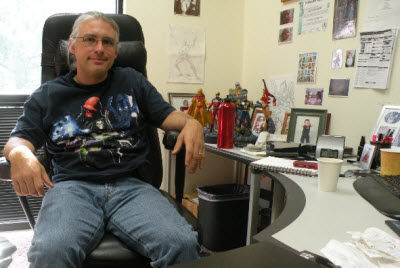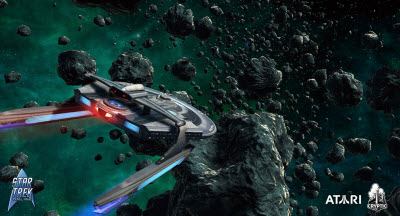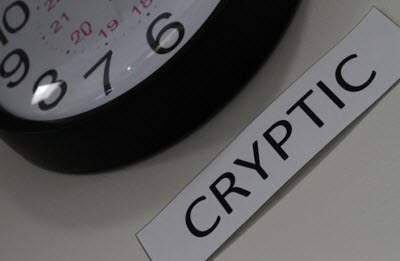 [Editor’s note: check out our awesome video of Star Trek Online. Photos courtesy of Cryptic, Alexa Lee].
[Editor’s note: check out our awesome video of Star Trek Online. Photos courtesy of Cryptic, Alexa Lee].
Cryptic Studios is one of the few companies that has made a living at making massively multiplayer online games and lived to tell about it. Since 2000, the company has created three successful MMOs: City of Heroes, City of Villains, and Champions Online.
But now it has a chance for the big time with Star Trek Online, a new MMO set for release in 2010. It is the first major online game based on the Star Trek franchise, and it’s a small miracle that it landed in the hands of the game developers at Cryptic Studios, a subsidiary of video game publisher Atari.
Los Gatos, Calif.-based Cryptic is a scrappy company that has survived ups and downs in an industry where dozens of MMO makers have vaporized over the years. But the timing is good. Star Trek fans, known as Trekkies, have been waiting for an online game where they could play by the millions forever. And the Star Trek movie that came out in the summer was a blockbuster, reawakening interest in the aging franchise. Now all that Cryptic has to do is finish the game at warp speed and it will have a chance at something that doesn’t happen often: a hardcore online game that is accessible enough to have broad mass market appeal.
 Making a game for Trekkies and gamers alike
Making a game for Trekkies and gamers alike
Building the game is a huge responsibility, since Trekkies and sci-fi gamers alike will have high expectations, said Craig Zinkievich, executive producer of the game, in an interview.
“The good thing is that the team is really excited about making it,” said Zinkievich (pictured). “It is such a stories franchise, such an exciting universe to work in. It really is a chance of a lifetime for us to be able to work on this product.”
The property has been cursed in a way. The previous game developer that worked on it went belly up. Making a success out of a brand like Star Trek might seem like a no-brainer. But it’s not so easy to make an MMO.
“One of the hardest thing to do is to create an MMO because there are so many pieces to it,” said Zinkievich. “Companies keep failing because the technology kills them. We’ve got an engine for our games that is mature. Once you’ve shipped one MMO, your chances of doing another are much better.”
 Cryptic’s humble beginnings
Cryptic’s humble beginnings
Cryptic is not a company that you would have bet on as a survivor in the game industry. It was founded in 2000 with some serious bubble money. Michael Lewis, a graphics and chemistry expert, founded Stellar Semiconductor, a 3-D graphics company that he sold at the height of the bubble to chip maker Broadcom. He came out of that deal with millions of dollars. Then, by chance, he met some former Atari game developers at a New Year’s Eve party. Since he was a game fan, he decided to use his money to start Cryptic with his friend Rick Dakan and the ex-Atari guys: Bruce Rogers, Matt Harvey, and Cameron Petty.
 They went to work on an online role-playing game, hiring comic book fanatic and role-playing game designer Jack Emmert. In 2002, they convinced NCSoft, a South Korean online game publisher looking to break into the U.S. market, to agree to publish their game, dubbed City of Heroes. Although Lewis was wealthy, Cryptic had to get by on a shoestring budget. And despite its relatively tiny team, it launched City of Heroes in April, 2004.
They went to work on an online role-playing game, hiring comic book fanatic and role-playing game designer Jack Emmert. In 2002, they convinced NCSoft, a South Korean online game publisher looking to break into the U.S. market, to agree to publish their game, dubbed City of Heroes. Although Lewis was wealthy, Cryptic had to get by on a shoestring budget. And despite its relatively tiny team, it launched City of Heroes in April, 2004.
City of Heroes proved addictive. You could create your own superhero and play with others in a huge city where bad guys roamed. Friends had to team up against the bad guys to defeat them. The game took off and quickly got more than 100,000 subscribers. That was enough to generate profits for Cryptic. It wasn’t a huge game in terms of numbers, but the fans were loyal because Cryptic kept churning out new missions and adventures.
The profits gave Cryptic enough money to do a second game, City of Villains. And since City of Villains used the same fundamental technology, or engine, as City of Heroes, it wasn’t that costly to make. Through NCSoft, Cryptic was able to launch City of Villains in October, 2005. Cryptic earned a reputation for getting things done.
That was more than what could be said for other online games. NCSoft got into trouble with its agreement to publish Tabula Rasa, a sci-fi online game being created by game guru Richard Garriott. Garriott spent tens of millions of dollars and six years making the game. But it flopped when it came out, and NCSoft had to shut down the game in February. Tabula Rasa was perhaps the biggest financial flop of all time. Its big-spending ways were the exact opposite of the way that Cryptic has learned to operate.
 A kick in the gut from Spider-Man
A kick in the gut from Spider-Man
Meanwhile, Cryptic’s modest success led to more deals. The superhero games logically led to a discussion with Marvel, the owner of superhero franchises from Spider-Man to Iron Man.
Marvel had long licensed its superheroes for use in console and PC games. But it had never commissioned a successful online game. At first, the game was started under an agreement with NCSoft. Then the license was transferred to Microsoft, which wanted to produce big online games for both the PC and the Xbox. Marvel announced a deal with Microsoft and Cryptic in September, 2006.
Cryptic Studios built its team working on the Marvel game to 70 people. It should have been the company’s shot at a mass appeal game. But, abruptly, Marvel and Microsoft got in a dispute. In 2007, they canceled the Marvel online game. The Marvel Universe license was eventually renegotiated and given to a new developer, Gazillion. Cryptic got the rug pulled out from under it.
 “It was like a kick in the gut,” said Emmert (pictured), who is now chief creative officer at Cryptic. “It was canceled for reasons I didn’t know, and I still don’t know.”
“It was like a kick in the gut,” said Emmert (pictured), who is now chief creative officer at Cryptic. “It was canceled for reasons I didn’t know, and I still don’t know.”
That was a period of crisis for the company; it was definitely one of the times when Cryptic was two months away from shutting down. In 2007, desperate for cash after the collapse of the Marvel deal, Cryptic sold the rights to its City of Heroes and City of Villains games to NCSoft. That gave Cryptic enough money to continue development on what would become Champions Online, another superhero game. Cryptic found a publisher for the online game in Take-Two Interactive’s 2K Games division.
 Cryptic’s big break
Cryptic’s big break
Then there were a couple of pieces of good luck. The Star Trek property broke loose from a game developer that had locked up the rights. Perpetual Entertainment, a startup in San Francisco with funding from Francisco Partners, had been working on a Star Trek online game under license from Paramount Pictures for years. But it failed to make enough progress and had to shut down after a series of layoffs in late 2007 and early 2008. Emmert said his people had been friendly to the Perpetual team and Francisco Partners. It started talking to them about taking over Star Trek Online.
 Cryptic put five people to work on a prototype for the game, and they had working code five weeks later which they showed to Paramount. They secured the license in January, 2008. Cryptic made some offers to some of Perpetual’s people, but none of them wanted to leave San Francisco for the suburbs of Los Gatos.
Cryptic put five people to work on a prototype for the game, and they had working code five weeks later which they showed to Paramount. They secured the license in January, 2008. Cryptic made some offers to some of Perpetual’s people, but none of them wanted to leave San Francisco for the suburbs of Los Gatos.
That deal made Cryptic a lot more attractive to game publishers, who have become wary of the MMO market because of all of the failures and because the one major success, World of Warcraft, has vanquished most of its competition. In December, 2008, Cryptic agreed to be acquired by Atari, which was in a  regeneration mode after a long period of struggle.
regeneration mode after a long period of struggle.
Game developers also came out of the woodwork. Some of them came to Zinkievich’s office, pleading to be assigned to the project while dressed as their favorite Star Trek characters. Under Atari, during the past year, Cryptic has been able to add more than 100 employees.
Cryptic’s Star Trek team huddled and figured out what they wanted to do. They started with a blank whiteboard and wrote down all of the things they thought a Star Trek game had to have. They matched that up against what they had learned from making several other MMOs.
Another piece of good fortune helped Cryptic expand. In the middle of 2008, San Jose, Calif.-based Flagship Studios went under. That company had developed an ambitious game, Hellgate: London. But the game flopped and Flagship couldn’t recover. Cryptic was able to hire a bunch of its developers, including Bill Roper, the founder of Flagship. Roper became design director at Cryptic and he helped direct the team producing Champions Online.
 Making Star Trek Online
Making Star Trek Online
Cryptic’s designers looked at Perpetual’s concept art for the game. But they quickly decided they had to start from the ground up, Zinkievich said. They didn’t even look at the code that had already been done. Rather, they decided to use their own Cryptic game engine, which had been evolving over the years and was battle-tested.
That allowed Cryptic to work on the game with a smaller team of about 50 of the company’s 250 employees. They gradually built the team up at the same time that they were in heavy development on Champions Online.
 The team knew they had to do justice to the franchise that has been around since Gene Roddenberry created the TV series in the 1960s. There were lots of Trek fans already working at Cryptic, but the team also benefited from the lore about Star Trek that is scattered across the Internet at sites like StarTrek.com and Memory Alpha. The team regularly watched episodes of Star Trek in the company’s cafeteria.
The team knew they had to do justice to the franchise that has been around since Gene Roddenberry created the TV series in the 1960s. There were lots of Trek fans already working at Cryptic, but the team also benefited from the lore about Star Trek that is scattered across the Internet at sites like StarTrek.com and Memory Alpha. The team regularly watched episodes of Star Trek in the company’s cafeteria.
Champions Online shipped in September. A smaller team continues to work on enhancements for the game, which is operated much like a service. In that sense, the task of making an online game and keeping it fresh never ends. But some of the employees have now been shifted to work on Star Trek Online.
Emmert and Zinkievich say they have remained true to the Star Trek canon, but have come up with enough original material in the form of missions that will keep fans from getting bored. In contrast to the online game Star Wars Galaxies, they aren’t straying too much from the fun stuff: being a Star Fleet captain running a space ship and fighting with the enemies of the Federation.
 Welcome aboard, Captain
Welcome aboard, Captain
Cryptic showed off its first playable version of the game to fans at the Penny Arcade Expo in Seattle, a game fan event where 70,000 people attended. The game starts in the year 2409, after the events of the Star Trek Nemesis movie. Players start in space as the captains of their own starships. You can fight the Klingons in your starship and perform missions on the ground on planets that you visit. Players can team up together in “away teams” as large as five. So the games can be played in a social setting. The idea was to live up to the series’ promise of “boldly going where no man has gone before,” Emmert said.
Emmert has tried to learn from all of Cryptic’s hardships. His main goal is to get Zinkievich’s team to focus on making a great game. That is, they should focus on the fact that this game is all about Star Trek. They should focus on how to make a game that is fun for anyone to play, even non-Trekkies.
 Since Atari isn’t the strongest of game companies, there isn’t a lot of marketing money it can spend on the game. That puts all the more pressure on Cryptic to create a game that will spread by word of mouth. Cyptic has another unannounced game underway. But with luck, Star Trek Online will be the game that makes Cryptic world famous.
Since Atari isn’t the strongest of game companies, there isn’t a lot of marketing money it can spend on the game. That puts all the more pressure on Cryptic to create a game that will spread by word of mouth. Cyptic has another unannounced game underway. But with luck, Star Trek Online will be the game that makes Cryptic world famous.
VentureBeat's mission is to be a digital town square for technical decision-makers to gain knowledge about transformative enterprise technology and transact. Learn More
